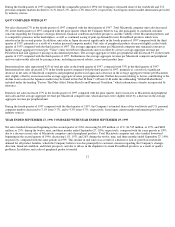Apple 1997 Annual Report Download - page 22
Download and view the complete annual report
Please find page 22 of the 1997 Apple annual report below. You can navigate through the pages in the report by either clicking on the pages listed below, or by using the keyword search tool below to find specific information within the annual report.small segment of the user population that tends to purchase new technology prior to its acceptance by the majority of users ("early adopters");
purchases in satisfaction of pent-up demand by users who anticipated new technology and, as a result, deferred purchases of other products;
and overordering by dealers who anticipate shortages due to the aforementioned factors. These factors may be offset by others, such as the
deferral of purchases by many users until new technology is accepted as "proven" and for which commonly used software products are
available; and the reduction of orders by dealers once they believe they can obtain sufficient supply of products previously in backlog.
Backlog is often volatile after new product introductions due to the aforementioned demand factors, often increasing coincident with
introduction, and then decreasing once dealers and customers believe they can obtain sufficient supply of the new products. The Company has
in the past experienced difficulty in anticipating demand for new products, resulting in product shortages which have adversely affected the
Company's operating results.
The measurement of demand for newly introduced products is further complicated by the availability of different product configurations, which
may include various types of built-in peripherals and software. Configurations may also require certain localization (such as language) for
various markets and, as a result, demand in different geographic areas may be a function of the availability of third-party software in those
localized versions. For example, the availability of European-language versions of software products manufactured by U.S. producers may lag
behind the availability of U.S. versions by a quarter or more. This may result in lower initial demand for the Company's new products outside
the U.S., even though localized versions of the Company's products may be available.
The increasing integration of new or enhanced functions and complexity of operations of the Company's products also increase the risk that
latent defects or other faults could be discovered by customers or end-users after volumes of products have been produced or shipped. If such
defects were significant, the Company could incur material recall and replacement costs under product warranties.
The Company has announced plans for two operating systems. The Company plans to continue to introduce major upgrades to the current Mac
OS and later introduce a new operating system (code named "Rhapsody") which is expected to offer advanced functionality based on Apple
and NeXT software technologies. However, the NeXT software technologies that the Company plans to use in the development of Rhapsody
were not originally designed to be compatible with the Mac OS. As a result, there can be no assurance that the development of Rhapsody can
be completed at reasonable cost or at all. In addition, Rhapsody may not be fully backward-compatible with all existing applications, which
could result in a loss of existing customers. Finally, it is uncertain whether Rhapsody or the planned enhancements to the current Mac OS will
gain developer support and market acceptance. Inability to successfully develop and make timely delivery of a substantially backward-
compatible Rhapsody or of planned enhancements to the current Mac OS, or to gain developer support and market acceptance for those
operating systems, may have an adverse impact on the Company's consolidated operating results and financial condition.
COMPETITION
The personal computer industry is highly competitive and is characterized by aggressive pricing practices, downward pressure on gross
margins, frequent introduction of new products, short product life cycles, continual improvement in product price/performance characteristics,
price sensitivity on the part of consumers, and a large number of competitors. The Company's consolidated results of operations and financial
condition have been, and in the future may continue to be, adversely affected by industrywide pricing pressures and downward pressures on
gross margins. The industry has also been characterized by rapid technological advances in software functionality and hardware performance
and features based on existing or emerging industry standards. Many of the Company's competitors have greater financial, marketing,
manufacturing, and technological resources, as well as broader product lines and larger installed customer bases than those of the Company.
19
























